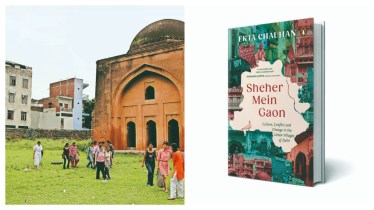By Amitabh Ranjan
Delhi would appear a phantasmagoria to the uninitiated. Reasons abound. From amidst cacophony in crowded markets arise monuments from another era, desperately trying to make their presence felt. A tonga moving in tandem with a swanky Merc honking to find past its way. Connoisseurs in snazzy outfits partaking of sushi, pasta or salad in a chic restaurant, next door to a very down-to-earth chhole-bhature joint serving its oil-dripping specialty to a different class of denizens in their sweat and grime. The city lives in many layers. Urbanisation has run amok. Delhi’s architectural heritage, its earliest villages and neighbourhoods, have been erased in good measure, both physically and emotionally.
The contemporary itself is in a flux. For someone who was born in one of its villages that remains only in traces, walked the streets and parks as they once were, has seen the traditional way of life being taken over by modernity, longing for the years gone by is a daily affair. An encounter between the legacy and the new can spring many thoughts. It is with a sense of lament, hope, concern, and even foreboding that Ekta Chauhan pens Sheher Mein Gaon, a book that chronicles the urban villages of the national capital.
The book attempts to make sense of the many conflicts embedded in the city’s spaces and psyche—rural past, contemporary conflicts, belongings, displacement, memories, and the future. Chauhan paints her personal stories into a larger canvas of the city’s march through the ages, bringing in observations, fieldwork, memories, oral histories, and academic accounts to unravel an enigma called Delhi. It is not for nothing that the city has been a wellspring for authors of fictional and non-fictional tomes. Rana Safvi, RV Smith, William Dalrymple, Sam Miller, Khushwant Singh, Arundhati Roy, Anuja Chauhan are just a few popular names who have made the city of Delhi their muse. There are many others. Chauhan adds an all-new dimension by tracing the rural embedded into what she calls a metropolis “on steroids”.
Delhi could represent any Indian urban sprawl where old settlements dwell in the shadow of skyscrapers and where slums shake a leg with tony gated colonies. The absence of a holistic town planning has meant that Indian cities are just islands of urbanity. What makes Delhi stand apart is its unique evolution through seven capitals that it is believed to be built upon and around. The juggernaut of modernisation has trampled upon the traditional way of life and made land the most contested and coveted commodity.
A new-found opulence and opportunities, an unending stream of migrants pouring in with dreams in their eyes and a constant collision of legacies, economies and cultures make Delhi a living conundrum, enticing and abhorring at the same time. Chauhan’s stories emanate from the streets and bylanes of the city’s urban villages, some well known, some not so— Khirki, Hauz Khas, Kalu Sarai, Shahpur Jat, Begumpur, Deoli, Mitraon, Sungarpur and Sonipat, the last being the latest hub of urbanisation on the northern fringe of Delhi. Its transformation from a rural agrarian belt into a burgeoning centre of education and urbanisation mirrors what happened with Delhi’s villages.
As the chronicler of the city many have written about, the author has a unique vantage point. Born in one of its oldest villages, brought up in a traditional family set-up, educated in an elite city institution, and now teaching in one of the top private universities in the city’s vicinity, she is able to intimately weave many strands of a changing landscape—building and renting boom, coaching centres, boutique bazaars, grub hubs, an unending stream of workers and job aspirants in search of livelihood, caste and class divisions, and administrative apathy—into a single cogent narrative.
The book raises some pertinent questions: Who owns Delhi? Where will it go from here? Will the bygone be erased for ever from the memory? Can there be ever a co-mingling in terms of shared values, heritage and a sense of belonging to a place that is everyone’s? And, most importantly, what is urban development? In her ‘Introduction’, Chauhan says urban villages of Delhi are not just vestiges of the past but active sites of negotiations, where histories, economics and cultures collide and evolve. She brings it out clearly in the chapters. Hers is an insight worth looking into for all those who have a stake in Delhi and the way the city works out its future.
The writer is a former journalist who teaches at Patna Women’s College
Sheher Mein Gaon: Culture, Conflict and Change in the Urban Villages of Delhi
Ekta Chauhan
Penguin Random House
Pp 224, Rs 399
